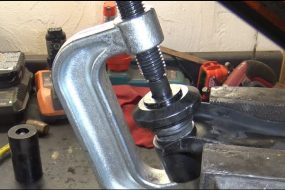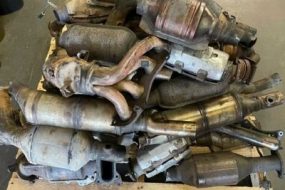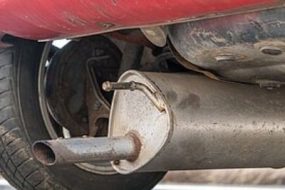
Brake fluid is a mixture of organic and inorganic chemicals that are used in the braking system of vehicles. It is a type of hydraulic fluid that makes sure that power is transferred between parts of the brake system of a vehicle.
It provides excellent friction between brake pads and rotors, which allows the vehicle to stop quickly whenever force is applied to the brake pedal. However, what if brake fluid touches the car paint, what does brake fluid do to car paint?
Brake fluids are essentially made up of glycol which can react aggressively with car paint and act like a solvent that can spoil or wash off your car’s paint, it will eat your paint coating and cause it to peel.
What is a Brake Fluid?
Brake fluids are simply substances that help your brakes work. Brake fluid contains a chemical called antifreeze and acts as an anti-freeze when your car overheats.
They are used for braking in cars and trucks, as well as other vehicles. It’s also sometimes used in aircraft, boats, and trains. It also helps lubricate the moving parts of your brakes so they don’t wear out too quickly.
Should Brake Fluid Touch Car Paint?
You should keep your car away from brake fluids if it has paint on it because brake fluids can damage the clear coat on the paint job of your vehicle. The clear coat protects the base coat and helps prevent rusting or staining from other substances.
The closer brake fluid comes to touching this layer of protection, the more likely it is for damage to occur to your car’s paint. If the brake fluid touches your car’s paint, then there’s no telling how much money could be spent replacing parts like hoods or bumpers (which are often made of plastic).
Brake fluid contains chemicals that can eat away at plastic surfaces over time if left exposed long enough. If left untreated long enough in one spot where brake fluid has been spilled onto them before being cleaned off properly by professionals who know what they’re doing that part could be damaged.
What Does Brake Fluid Do to Car Paint?
If you have ever been in a situation where you saw your car’s paint fading after being exposed to brake fluid, then you know how important it is to get the damage repaired before it gets worse.
Brake fluid is a highly corrosive chemical that can damage a car’s paint if it is not cleaned up quickly.
Brake fluids, when they get on a car’s paint can cause rust and corrosion on the surface of your vehicle’s bodywork, including its metal parts like bumpers and grilles as well as plastic components such as headlights or taillights.
Similarly, brake fluid also causes rusting around bolts that hold on components inside your motor vehicle, a very good example is the bolts that hold the seat.
The worst part about brake fluid getting into contact with your vehicle’s bodywork is that once this happens, there isn’t much hope for saving what was once a beautiful-looking automobile. This is because it will now be covered in ugly orange stains that will disfigure the car and ruin its beauty.
If this happens you might need to get a new paint job which will cost you a lot and all this is just to rectify the spots that have been damaged.
How Long Does it Take for Brake Fluid to Ruin Paint?
The answer to this question depends on a few factors;
- First, what kind of paint do you have on your car and how long have you been using it?
- Second, how much time your brake fluid has been sitting around before being used again?
- Third, what type of braking system you have installed on your car, do you have disc or drum brakes?
- Fourthly and finally, there’s the effect that weather can have on the longevity of your brake fluid when it comes time for cleaning up after an accident or other mishap with the vehicle itself.
The amount of damage that brake fluid does to a car’s paint is dependent on how long it has stayed on it.
When the brake fluids have stayed on the touch up car paint for less than 5 minutes, it most likely would have done no damage to the car’s paint.
However, it if stays for longer than 5 minutes, you’ll start to see signs of dull markings on the car’s paint, and also the car’s paint would have been jeopardized in those areas.
The longer the brake fluid stays on the car paint the more damage it does, when it stays longer than 5 minutes you’ll start to see visible stains and even stripes would be seen.
When the brake fluids stay for too long, the damage becomes obvious and permanent.
What to Do if You Get Brake Fluid on Car Paint?
When you get brake fluids on your car paint, the first thing you should do is to get it off of the car’s paint as soon as possible before any damage is done. You can use a solvent to get the brake fluids off the car’s paint.
These solvents should be diluted according to instructions found online or with whatever kit comes with your new setup so as not to strip away too much protective layer.
How Do You Remove Brake Fluid From Car Paint?
You can use a simple solution of dish soap and water, or you can mix 1 part acid detergent with 5 parts white vinegar to create a powerful cleaner.
If your car has been sitting in the sun, it’s best to let the vehicle sit overnight before cleaning the top layer of paint. You should also take care that any rags or towels used are not contaminated with brake fluid by washing them separately as well.
Conclusion
Brake fluids can damage the paint job of any car so whenever you’re working with them, try as much as possible not to get the brake fluids on any part of your car’s paint. Also, make sure that the brake fluids don’t get on any bolt in any part of your car because it could cause corrosion.









